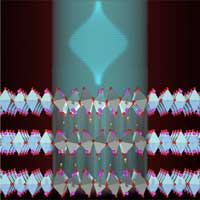 Scientists uncovered an anomalous metallic behavior in an otherwise insulating ceramic material. The team used ultrashort light pulses with a wide range of colors to watch what happens when the insulating quasi two-dimensional material La2CuO4 (LCO) becomes a three-dimensional metal through laser irradiation.
Scientists uncovered an anomalous metallic behavior in an otherwise insulating ceramic material. The team used ultrashort light pulses with a wide range of colors to watch what happens when the insulating quasi two-dimensional material La2CuO4 (LCO) becomes a three-dimensional metal through laser irradiation.
Thursday, March 12, 2020
Laser metallizes 2D insulator
 Scientists uncovered an anomalous metallic behavior in an otherwise insulating ceramic material. The team used ultrashort light pulses with a wide range of colors to watch what happens when the insulating quasi two-dimensional material La2CuO4 (LCO) becomes a three-dimensional metal through laser irradiation.
Scientists uncovered an anomalous metallic behavior in an otherwise insulating ceramic material. The team used ultrashort light pulses with a wide range of colors to watch what happens when the insulating quasi two-dimensional material La2CuO4 (LCO) becomes a three-dimensional metal through laser irradiation.
Universal 3D-printing nanocarrier ink paves way for personalized biomaterial implants
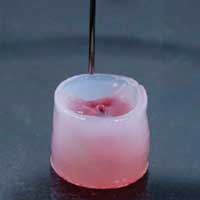 Researchers have produced a gel from cellulose fibres and biodegradable nanoparticles that liquifies when pressed through the nozzle of a 3D printer, but then quickly returns to its original shape.
Researchers have produced a gel from cellulose fibres and biodegradable nanoparticles that liquifies when pressed through the nozzle of a 3D printer, but then quickly returns to its original shape.
Nanoparticles and heat cure intestinal cancer in mice
 Researchers presented the test results of an innovative oncotherapy technology based on hyperthermia - heating a tumor to a certain temperature due to nanoparticles introduced into it. The drug based on cobalt ferrite nanoparticles cured 100% of the mice with intestinal cancer from the experimental group.
Researchers presented the test results of an innovative oncotherapy technology based on hyperthermia - heating a tumor to a certain temperature due to nanoparticles introduced into it. The drug based on cobalt ferrite nanoparticles cured 100% of the mice with intestinal cancer from the experimental group.
How impermeable is the impermeable graphene?
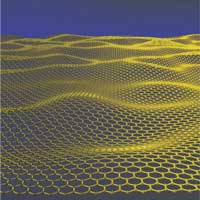 New experiments have placed the best limits yet on impermeability of graphene and other two-dimensional materials to gases and liquids. The work has also revealed that the carbon sheet can act as a powerful catalyst for hydrogen splitting, a finding that promises cheap and abundant catalysts in the future.
New experiments have placed the best limits yet on impermeability of graphene and other two-dimensional materials to gases and liquids. The work has also revealed that the carbon sheet can act as a powerful catalyst for hydrogen splitting, a finding that promises cheap and abundant catalysts in the future.
New nano strategy fights superbugs
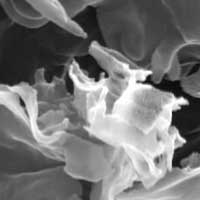 Scientists have a new strategy for 'trapping and zapping' antibiotic resistant genes, the pieces of bacteria that, even though theirs hosts are dead, can find their way into and boost the resistance of other bacteria.
Scientists have a new strategy for 'trapping and zapping' antibiotic resistant genes, the pieces of bacteria that, even though theirs hosts are dead, can find their way into and boost the resistance of other bacteria.
Gold nanoparticles uncover amyloid fibrils
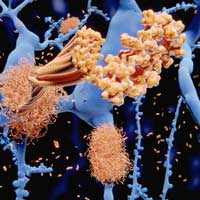 Scientists have developed powerful tools to unmask the diversity of amyloid fibrils, which are associated with Alzheimer?s disease and other neurodegenerative disorders. They made the breakthrough by developing gold nanoparticles that combine with cryogenic transmission electron microscopy, to provide rapid and unprecedented images of fibrils.
Scientists have developed powerful tools to unmask the diversity of amyloid fibrils, which are associated with Alzheimer?s disease and other neurodegenerative disorders. They made the breakthrough by developing gold nanoparticles that combine with cryogenic transmission electron microscopy, to provide rapid and unprecedented images of fibrils.
Dark excitons can make a high contribution to light emission from nanotubes
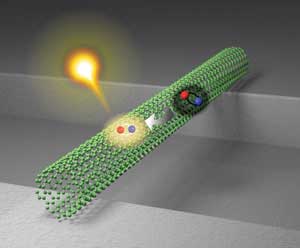 The high conversion of dark to bright excitons in long carbon nanotubes can lead to more efficient optoelectronics devices.
The high conversion of dark to bright excitons in long carbon nanotubes can lead to more efficient optoelectronics devices.
Ultrathin organic solar cell is both efficient and durable
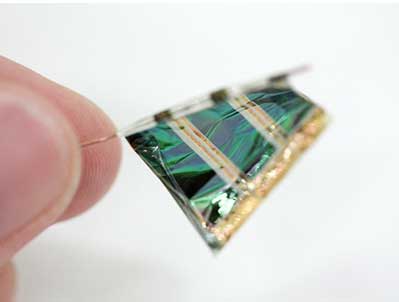 Using a simple post-annealing process, scientists created a flexible organic cell that degrades by less than 5 percent over 3,000 hours in atmospheric conditions and that simultaneously has an energy conversion ratio - a key indicator of solar cell performance - of 13 percent.
Using a simple post-annealing process, scientists created a flexible organic cell that degrades by less than 5 percent over 3,000 hours in atmospheric conditions and that simultaneously has an energy conversion ratio - a key indicator of solar cell performance - of 13 percent.
'Spillway' for electrons could keep lithium metal batteries from catching fire
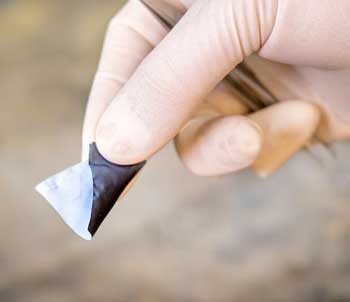 Nanoengineers developed a safety feature that prevents lithium metal batteries from rapidly heating up and catching fire in case of an internal short circuit.
Nanoengineers developed a safety feature that prevents lithium metal batteries from rapidly heating up and catching fire in case of an internal short circuit.
Subscribe to:
Comments (Atom)
